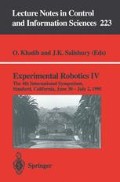Abstract
Multi-fingered robotic end-effectors have not yet made significant inroads into practical applications, partly due to the complexity of dextrous manipulation tasks. This paper develops an approach for assembling tasks from relatively simple phases which are punctuated by discrete events, signaling the transfer of operation to the next phase in a sequence. We examine the constraints active during phases, and develop methods for conducting smooth transitions between phases. Techniques for robust event detection in the presence of disturbances are also described. Experimental data is shown in support of the phase transition and event detection methods.
Preview
Unable to display preview. Download preview PDF.
References
Brock, D. L., “A sensor based strategy for automatic robotic grasping,” Massachusetts Institute of Technology Ph.D. Thesis, Department of Mechanical Engineering, 1993.
Brockett, R. W., “On the computer control of movement,” IEEE Int'l. Conf. on Robotics and Automation, 1988.
Brockett, R. W., “Dynamical systems and their associated automata, in Systems and Networks, Mathematical Theory and Applications, Academie Verlag, Berlin, 1994.
Cao, T., and Sanderson, A. C., “A fuzzy petri net approach to reasoning about uncertainty in robotic systems,” IEEE Int'l. Conf. on Robotics and Automation, 1993.
Cutkosky, M. R., and Hyde, J. M., “Manipulation control with dynamic tactile sensing”, 6th International Symposium on Robotics Research, Hidden Valley, Pennsylvania, 1993.
Eberman, B., and Salisbury, J. K., “Application of change detection to dynamic contact sensing,” Int'l Journal of Robotics Research, v. 13, n. 5, pp. 369–394, 1994.
Hogan, N., “Impedance control: an approach to manipulation: parts I, II, and III,” ASME Journal of Dynamic Systems, Measurement, and Control, v. 107, pp. 1–24, 1985.
Howe, R. D., “Dynamic tactile sensing,” Ph.D. Thesis, Stanford University, October 1990.
Hyde, J. M., and Cutkosky, M. R., “Contact transition control: an experimental study,” IEEE Int'l. Conf. on Robotics and Automation, 1993.
Hyde, J. M., “A phase management framework for event-driven dextrous manipulation,” Stanford University Ph.D. thesis, 1995.
Johansson, R. S., and Westling, G., “Afferent signals during manipulative tasks in man,” In Franzen, O., Westman, J. (eds.): Information processing in the somatosensory system: Proceedings of an International Seminar at the Wenner-Gran Center, Macmillan. New York, 1991.
Katayama, Y., Nanjo, Y., and Shimokura, K., “Event-driven motion-module switching mechanism for robot motion control: concept and experiment,” ASME Journal on Dynamic Systems and Control, v. 55, n. 1, 1994.
“Unified approach for motion and force control of robot manipulators: the operational space formulation,” IEEE Journal of Robotics and Automation, v. 3, n. 1, pp. 43–53, 1987.
McCarragher, B. J., and Asada, H., “A discrete event approach to the control of robotic assembly tasks,” IEEE Int'l. Conf. on Robotics and Automation, 1993.
Nagai, K., and Yoshikawa, T., “Dynamic manipulation/grasping control of multi-fingered robot hands,” IEEE Int'l. Conf. on Robotics and Automation, 1993.
Schneider, S. A., “Experiments in the dynamic and strategic control of cooperating manipulators,” Stanford University Ph.D. thesis, 1989.
Sobh, T. M., and Bajcsy, R., “Autonomous observation under uncertainty,” IEEE Int'l. Conf. on Robotics and Automation, 1992.
Son, J. S., Monteverde, E. A., and Howe, R. D., “A tactile sensor for localizing transient events in manipulation,” IEEE Int'l. Conf. on Robotics and Automation, 1994.
Tremblay, M. R., and Cutkosky, M. R., “Estimating friction using incipient slip sensing during a manipulation task,” IEEE Int'l. Conf. on Robotics and Automation, 1993.
Tremblay, M. R., “Using multiple sensors and contextual information to detect events during a manipulation task,” Stanford University Ph.D. thesis, 1995.
Author information
Authors and Affiliations
Editor information
Rights and permissions
Copyright information
© 1997 Springer-Verlag London Limited
About this paper
Cite this paper
Hyde, J.M., Tremblay, M.R., Cutkosky, M.R. (1997). An object-oriented framework for event-driven dextrous manipulation. In: Khatib, O., Salisbury, J.K. (eds) Experimental Robotics IV. Lecture Notes in Control and Information Sciences, vol 223. Springer, Berlin, Heidelberg. https://doi.org/10.1007/BFb0035196
Download citation
DOI: https://doi.org/10.1007/BFb0035196
Published:
Publisher Name: Springer, Berlin, Heidelberg
Print ISBN: 978-3-540-76133-4
Online ISBN: 978-3-540-40942-7
eBook Packages: Springer Book Archive

